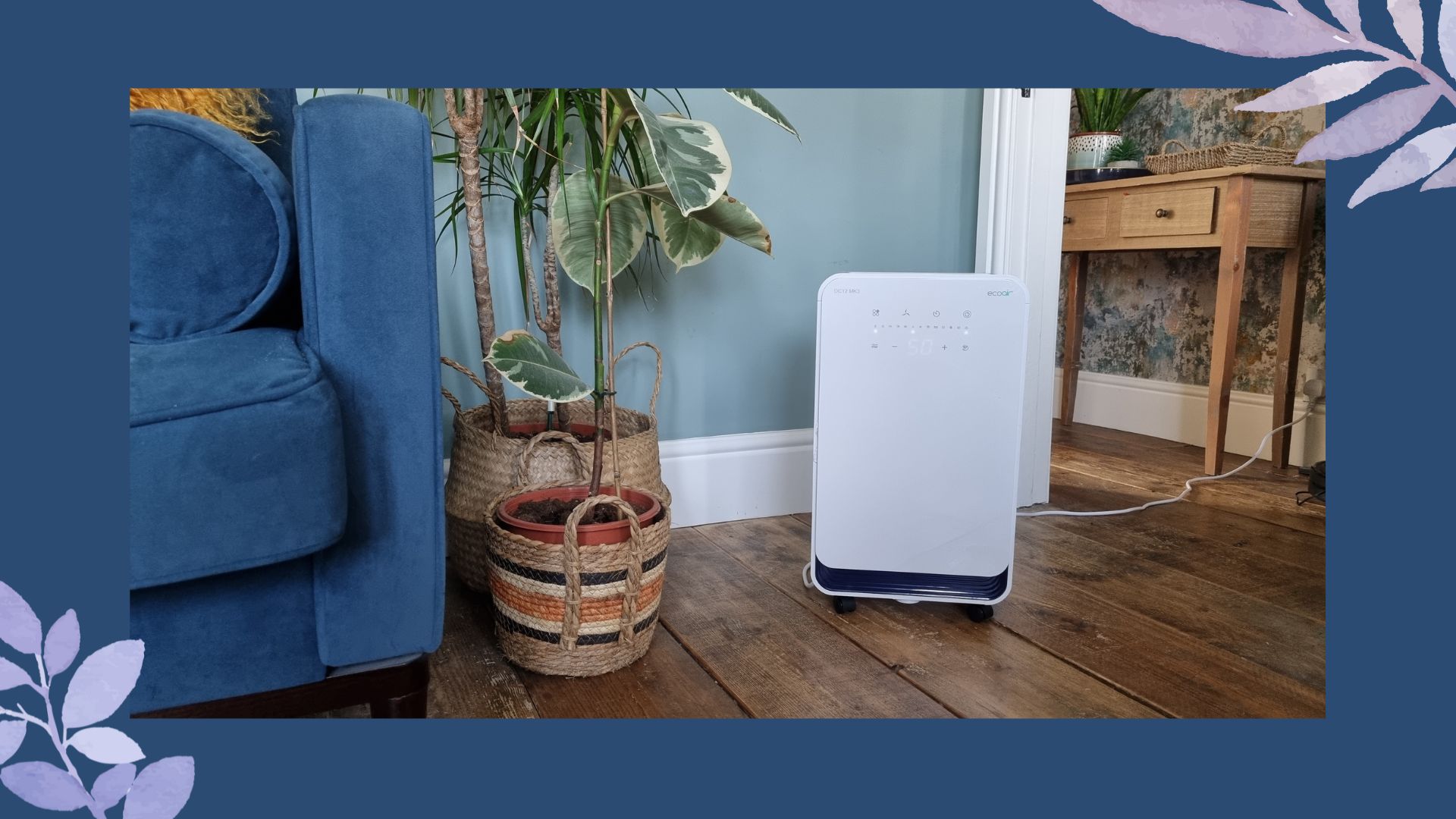
You never know when a dehumidifier might come in handy, whatever the time of year. In winter, it can combat condensation and damp. But you should also consider that mould thrives in warm, wet conditions. So while you might not be suffering condensation issues in summer, drying laundry inside on a hot but rainy day is an open invite for fungus to spread.
Given mould can exacerbate respiratory issues such as asthma, not to mention cause lasting damage to the fabric of your house, shopping for the best dehumidifier to keep it at bay is a smart move. And it's made even smarter if you can grab one of the best dehumidifier deals.
My own Victorian home suffers various issues that a dehumidifier can solve – like mould that forms on one wall of my living room and bedroom, and condensation that's particularly bad in my downstairs bathroom and living room – partially due to the fact that the kitchen is positioned between the two, and partially because... well, it's an old, poorly insulated house.
So I was eager to put some of the latest models to the test – the EcoAir DC12 MK3 being the most compact and affordable of the three – to see which would suit my home best. Here are my thoughts.
EcoAir DC12 MK3
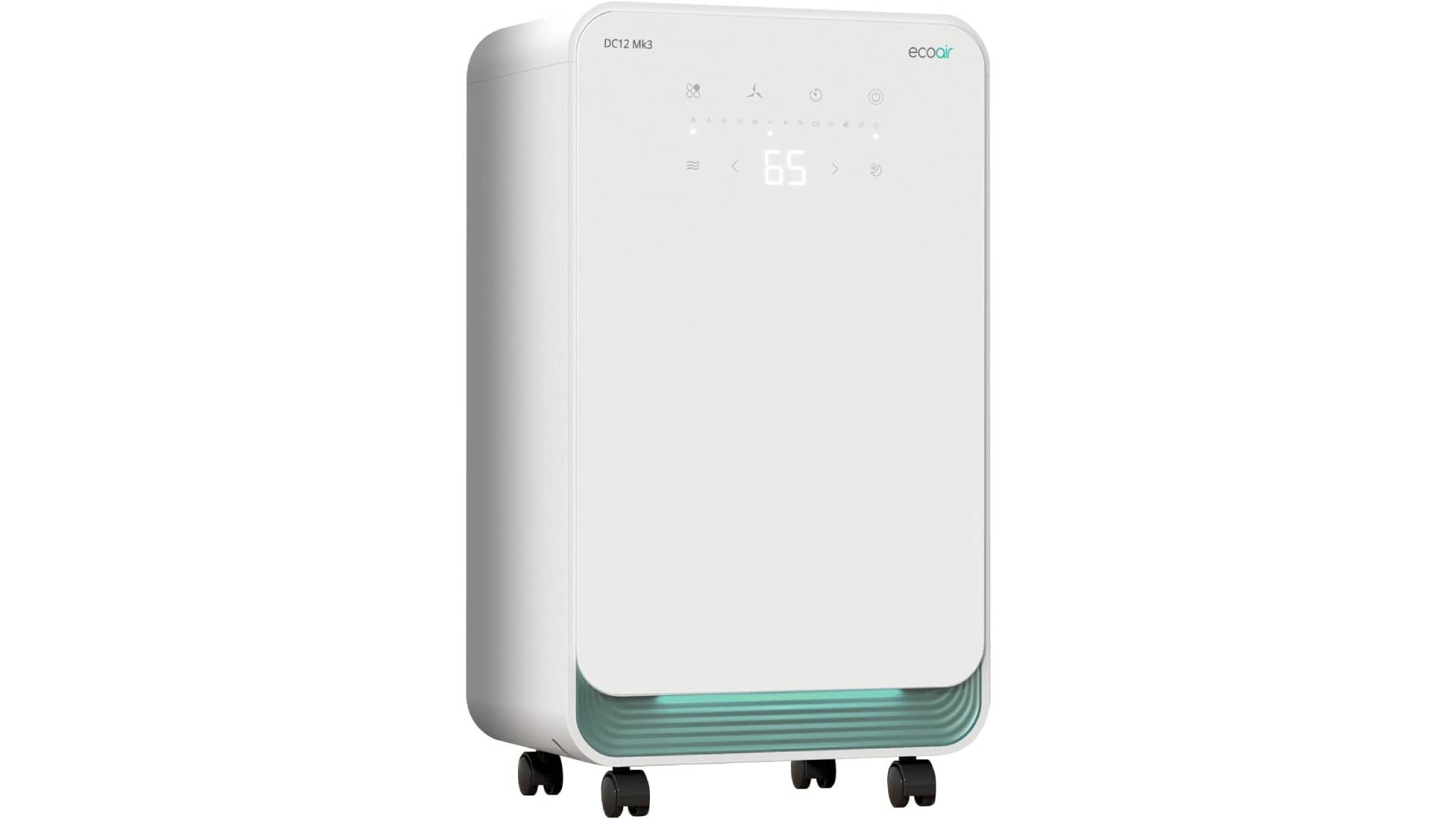
- RRP: £169.98
- Tank capacity: 2 litres
- Maximum extraction potential: 12 litres per day
- Size: 28 cm x 22 cm x 49 cm
- Weight: 9.5kg
First impressions
This dehumidifier is packaged neatly in cardboard, with handles that made it easy to carry into the house. Inside are dehumidifier, a plastic tube (more on that later) and an instruction booklet.
They say beauty is in the eye of the beholder, and granted, not everyone is going to excited by what is essentially a big white box full of tech. But in my view, the EcoAir is a smart-looking machine, and nice and compact.
Its rounded corners are pet- and child-friendly, and it really liked its contemporary touchscreen control panel. Visiting friends remarked on how 'cool' this was, although it does have slight drawbacks – it's quite hard to see the humidity percentage level in bright daylight. The icons are also very small, so you'll need to get your specs out to see what they are.
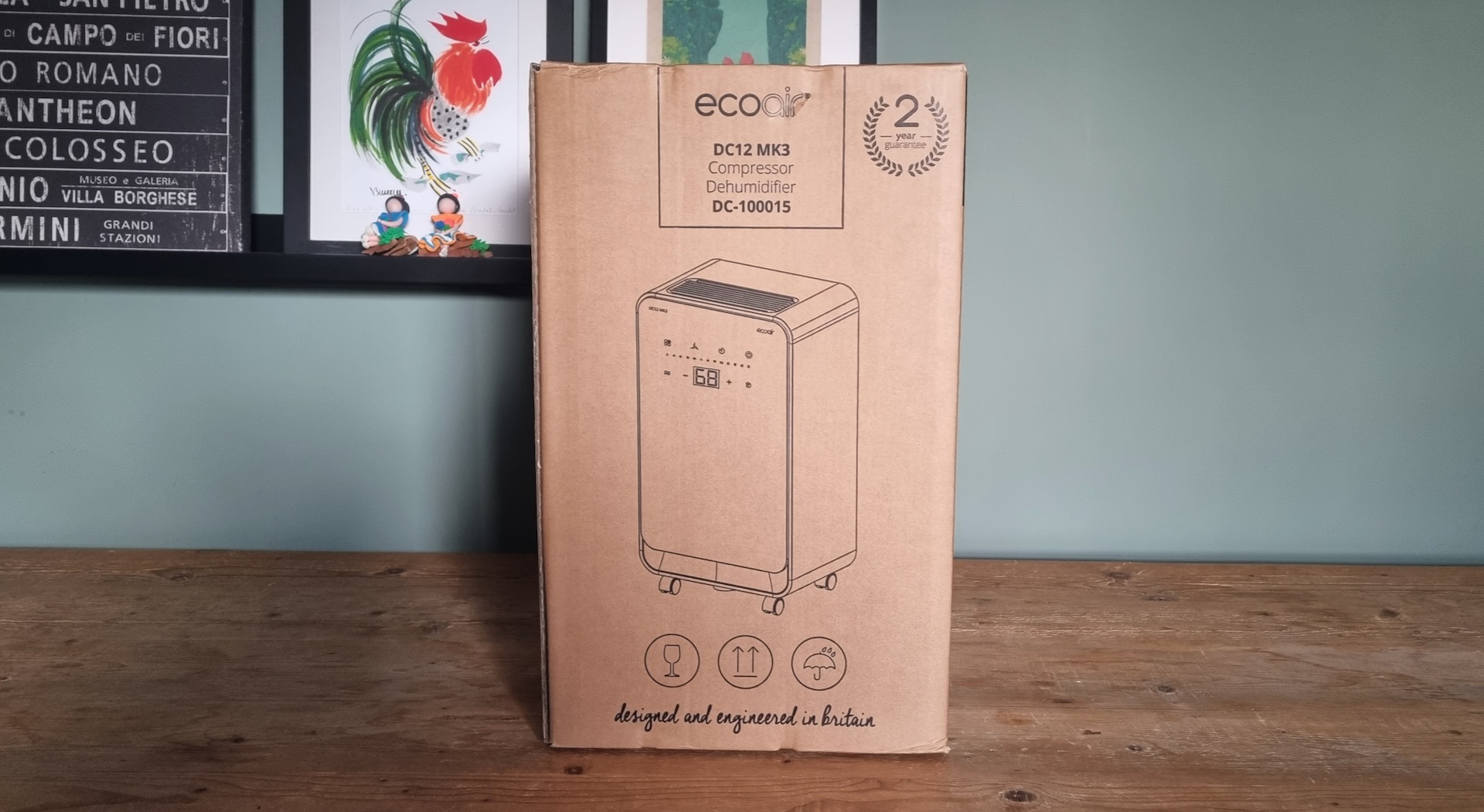
The buttons do make a satisfying beep as you press them – and it only takes the lightest tap for them to work. This is great if you aren't very strong, but it does mean you – or a passing cat or dog – can accidentally tap and change the mode. It's no big issue though, as you can hold down the sleep/child lock button down for five seconds to lock your settings in place.
In conclusion, I grew to love the EcoAir's appearance, and was happy to have it – and its snazzy display – on show.
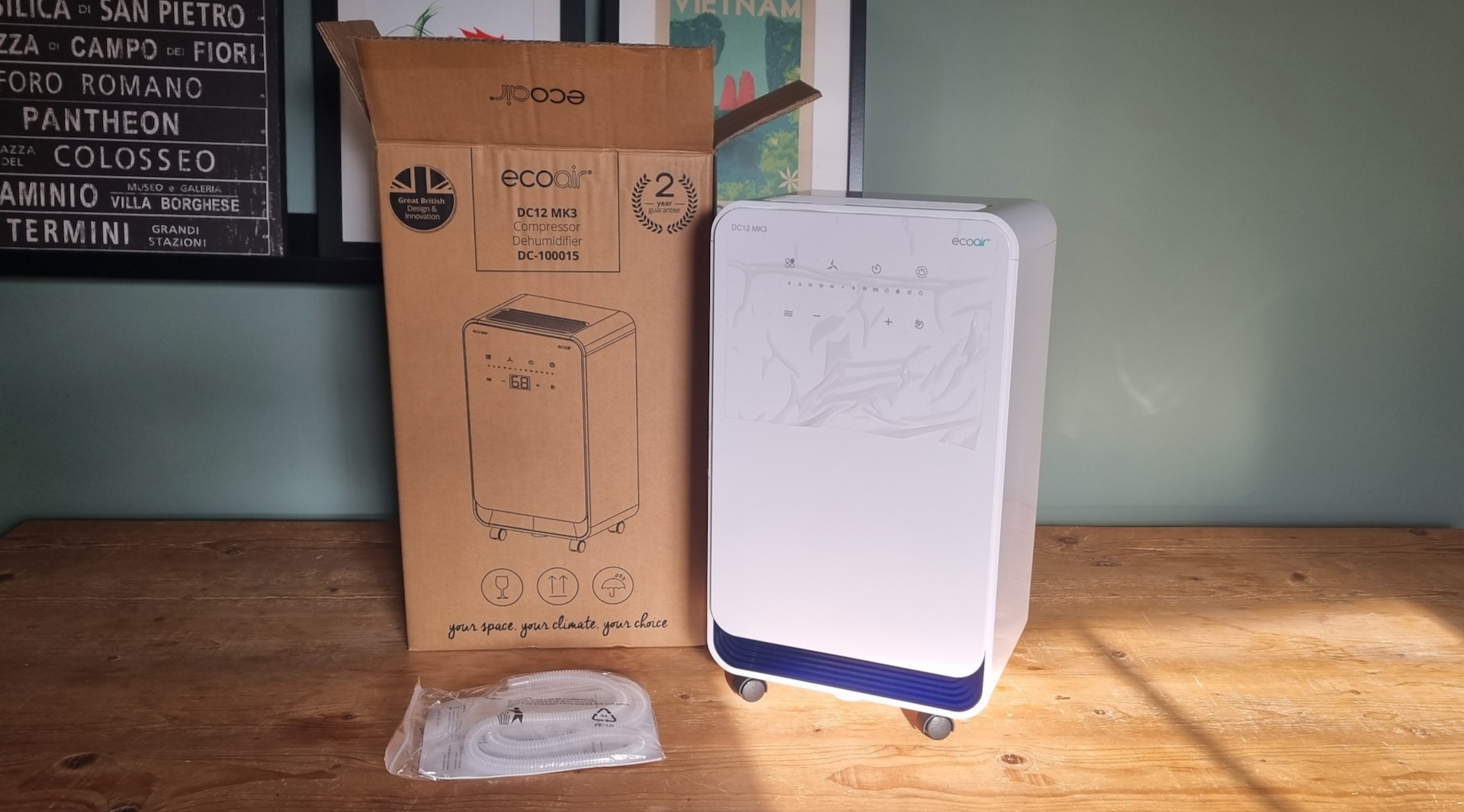
How I tested it
I tested the EcoAir alongside two other dehumidifiers – the MeacoDry ABC 12ltr compressor dehumidifier and the DeLonghi Tasciugo AriaDry Multi 16L compressor dehumidifier.
I've been using dehumidifiers for 15 years now, and have owned three different models during that time, and tested others. I'm always keen to give the reasons you should buy a dehumidifier – they really can make a huge difference, particularly if you suffer from a condition such as asthma, or live in a house that seems susceptible to condensation and mould.
This means I had a good idea of performance metrics that I could use as a fair comparison. To indicate how we test dehumidifiers I gave each unit marks out of five for the following criteria:
- Capacity and water tank: was it big enough; was it easy to remove/replace; was it easy to empty; was it easy to clean, etc.
- Ease of use: How easy was it to turn the dehumidifier on and off; find the right settings; read and operate the control panel; use functions such as timers, etc.
- Design and mobility: was the design attractive; was the dehumidifier supplied with castors; how good was the handle; was it heavy both empty and full of water, etc?
- Noise: was the unit loud?
- Effectiveness at drying washing: To test the capability of this dehumidifier for drying clothes I washed 7kg loads of bedding and clothing, weighing it when it was wet out of the machine, then again after a drying time of six hours to see how much water had been removed, also paying attention to the ambient room temperature. I always used the same 'drying room' – my dining room. I did this multiple times using different wash loads of fabrics, including cotton, denim and synthetics.
- Effectiveness of reducing humidity and condensation: I observed how well the dehumidifier was able to reduce mould and condensation in a room over one month.
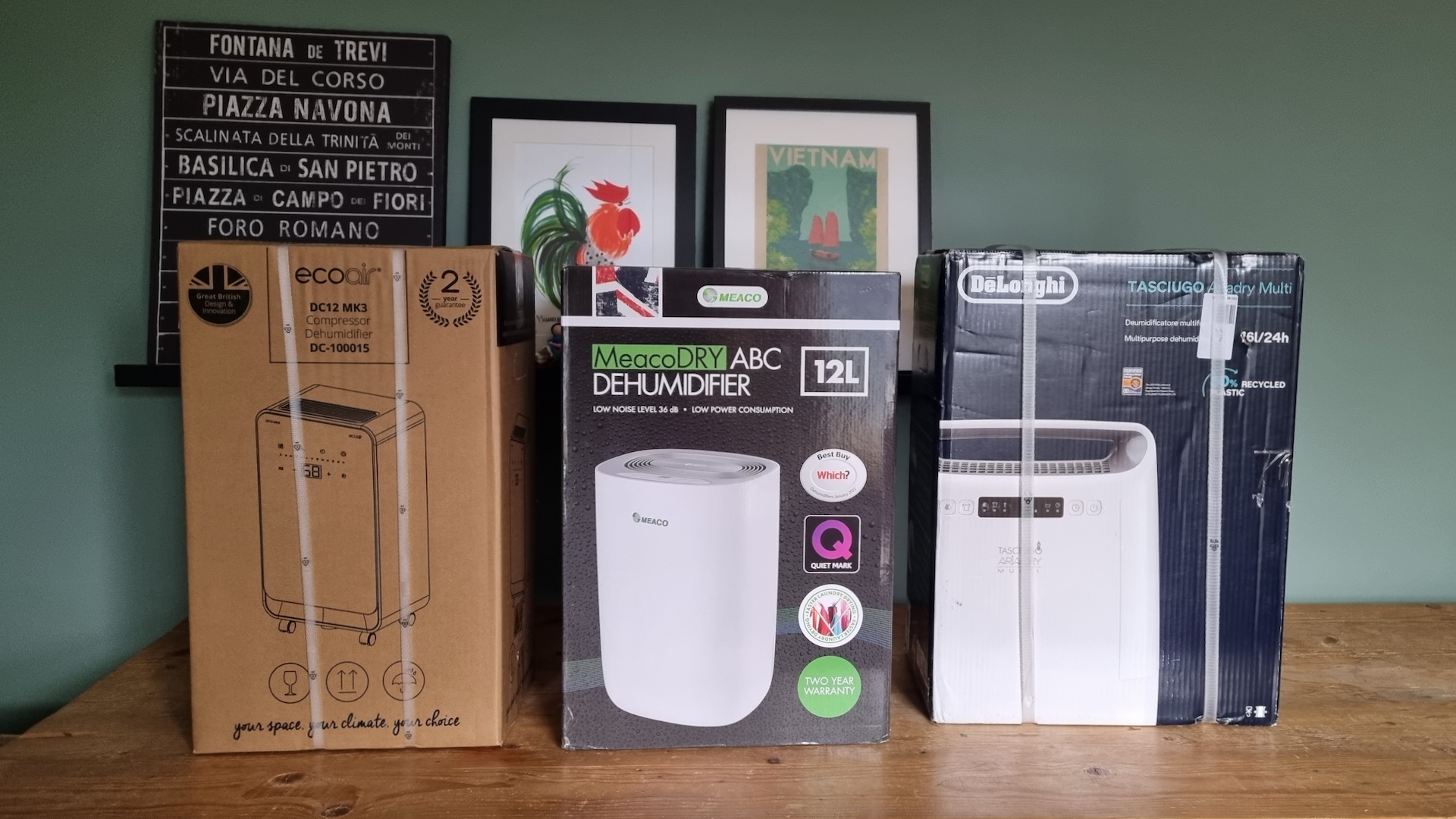
How well does the EcoAir DC12 MK3 dehumidifier perform?
Capacity and water tank
Like the MeacoDry model I tested, the EcoAir DC12 can remove up to 12ltrs of water from a home in 24 hours. Both have a continuous mode that allows you to pipe the water directly from the machine through a hose and into a larger vessel. That way, it can operate continuously, rather than shut down every time the built-in water tank fills up.
Thankfully, my home isn't humid enough for me to require this function. Though it's worth pointing out, if yours is, the EcoAir comes with a hose included, unlike other models (such as the Meaco). It measures a metre long, but does have some stretch in it.
The EcoAir DC12's water tank is the smallest of the tree models I tested, at 2 litres. The machine automatically shuts off when the tank is full – a feature I put to the test when I placed the unit in my bedroom to combat a mouldy corner. When I was initially bringing the humidity down, from a level of 71% to 55%, it took around 14 hours to fill completely.
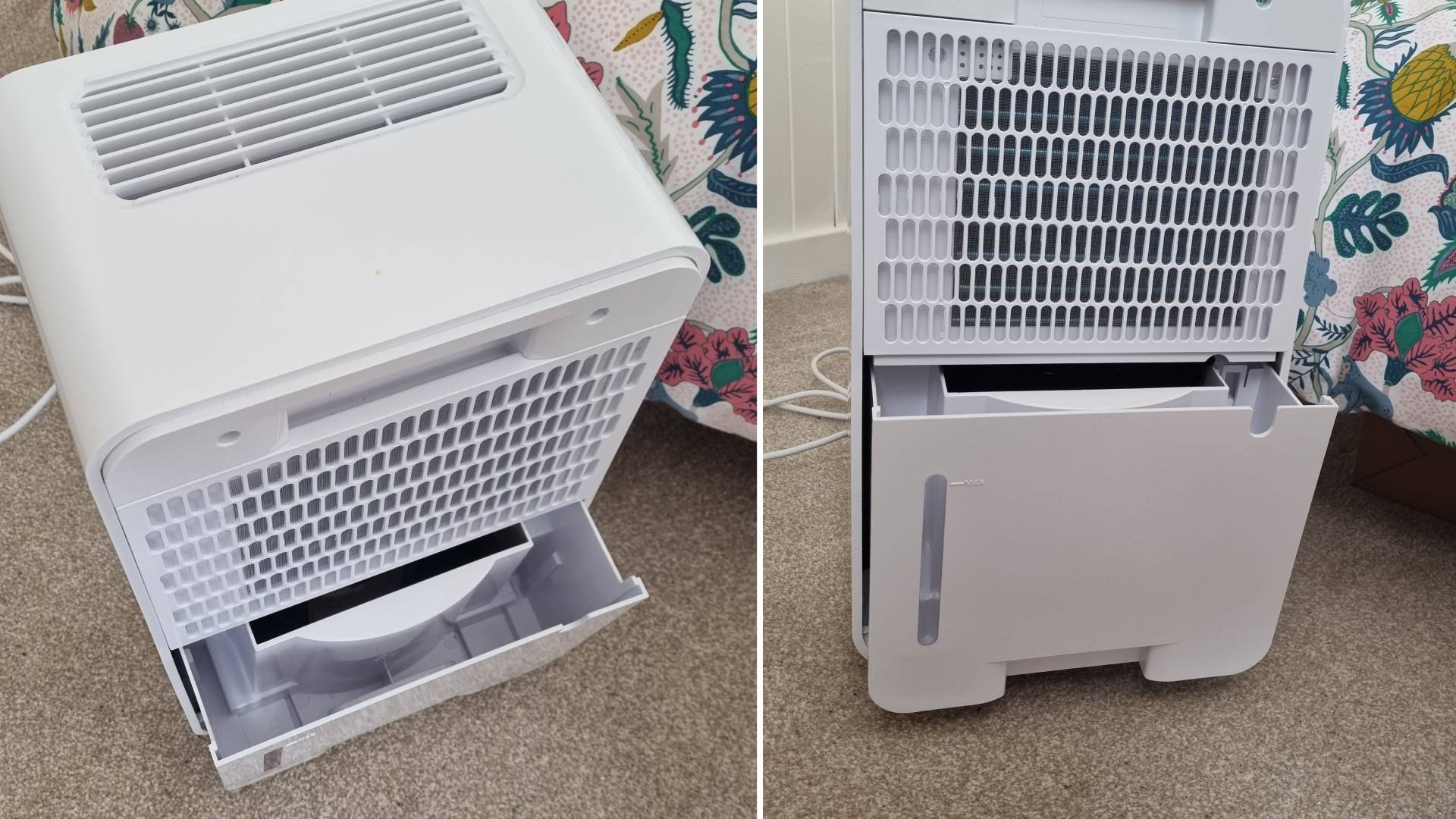
Of the three models I tested side by side, this was the only example of a water tank that didn't have a lid. This meant the water did slosh about a bit and wet the floor when the tank was full. A finger hole at the top makes it relatively easy to pull out, but it did get a bit sticky at times. I also had to give it a firm whack to get it back into the dehumidifier at times. A light will come on to warn you if you've not done the job properly!
Because the tank is quite slim and the corners sharp, I did find it relatively easy to empty. And despite the lack of any form of lid or spout, I could pour water directly into my houseplant pots without it overspilling.
WARNING: Never use water from your dehumidifier to water edible plants such as tomatoes, or as drinking water.
Noise
This is one of the EcoAir DC12's big selling points – to quote Bjork, it's oh so quiet. No, perhaps not the quietest of all time, but certainly quiet enough to qualify it as one of the best dehumidifiers for a bedroom.
Using a sound meter app on my smartphone, I took regular readings from the EcoAir. In my carpeted bedroom it measured, on average, 48dB on high fan mode, and a low 44dB on sleep mode. This compared to 59dB and 50dB, respectively, for the louder Meaco ABC. I happily let the EcoAir run overnight, and not once did it disturb me or draw a complaint from my husband, despite him being a light sleeper who often needs to rise early.
On a hard floor, it's slightly louder. I took night mode readings of around 48dB on wooden floorboards, rising to as high as 57dB on high fan mode. I quickly brought the volume down, however, by popping it on a rug...
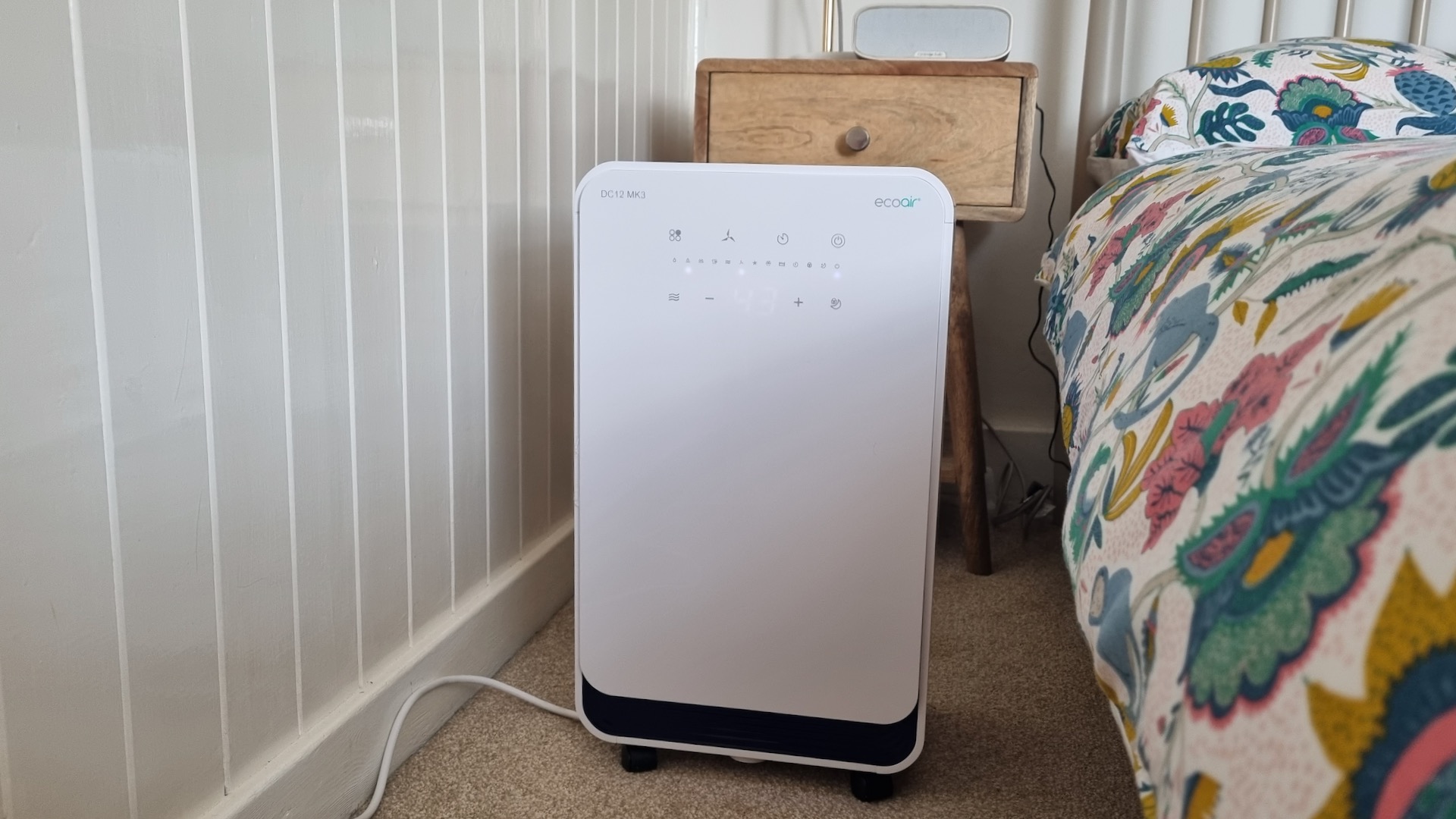
Effectiveness at drying laundry
Now to the most important feature of a dehumidifier for many people. The good news is, the EcoAir DC12 performs admirably in this area. In my opinion, it's not quite as good as the Meaco ABC, but it's not far off, and certainly good enough.
I tested various loads and tried to keep weights consistent. Typically, a 'mixed' laundry pile of mainly cottons and synthetics that weighed 7kg before washing, and 8.5kg after washing had lost around 1.25kg of weight after six hours of the EcoAir running in laundry mode and had removed 1.1litres of water.
At this six-hour point, synthetics like fleece dressing gowns were completely dry, and thin cotton pillowcases were iron dry. Thick, lined cotton dresses were still damp, but by hour nine they were ready to iron. At this point, a further 500ml of water had been removed from the air, and overall humidity had reduced from 65% (when the washing was first aired) to 55%.
Given that it usually takes two days for laundry to dry in my house, I was very impressed.
Warning: EcoAir does advise that you don't use the laundry mode for 'a long period of time or unattended', so I was always careful to shut off the appliance at night or when I left the house for more than a few minutes.
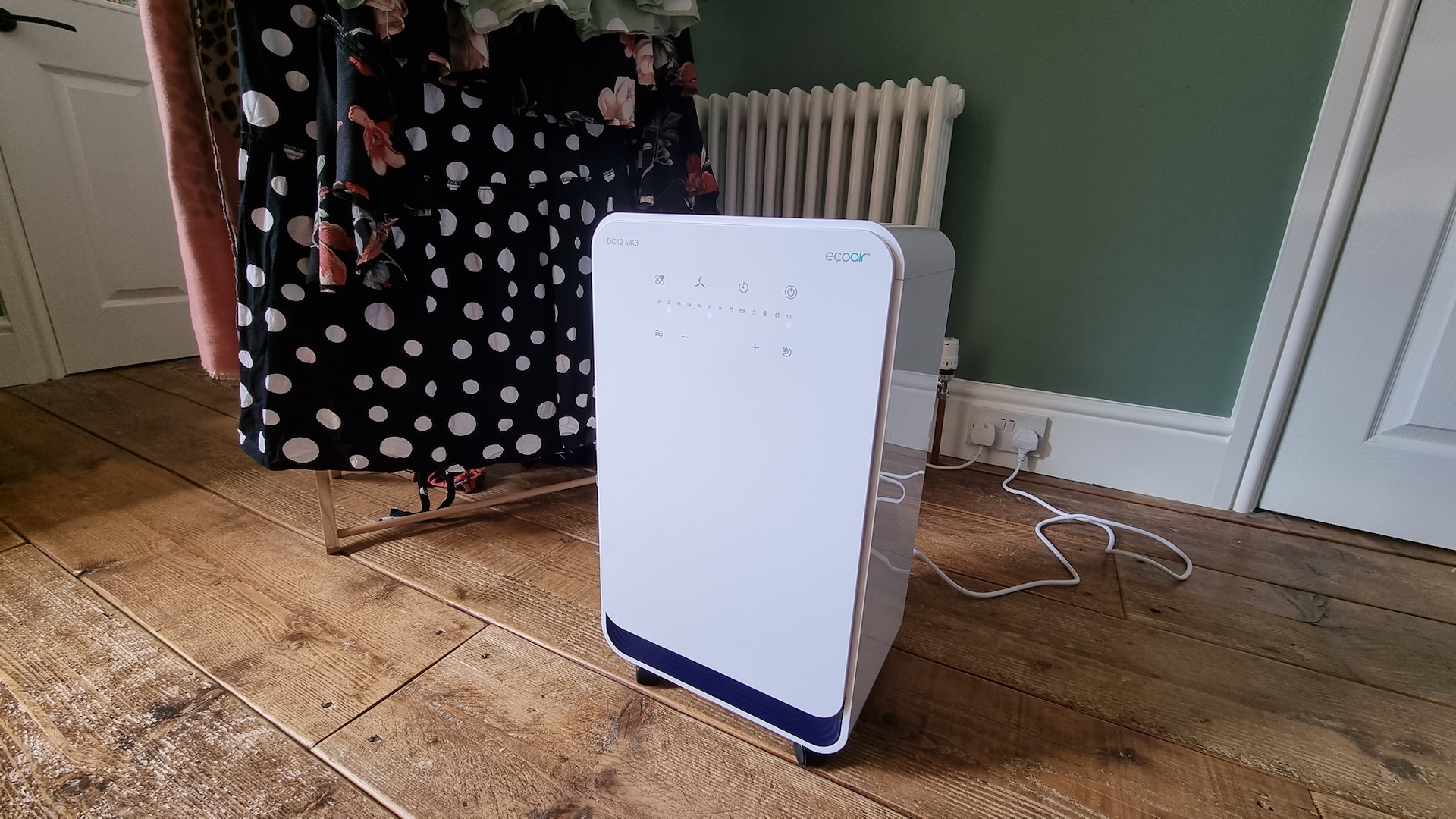
Effectiveness of removing humidity and condensation
The EcoAir was initially installed in my spare bedroom to tackle a damp patch that had formed in a corner. I then moved it into my living room where I have a slightly worse issue with a damp wall at the front of the house.
While the dehumidifier hasn't ultimately been able to 'fix' the latter issue, which will require building work, it's done a fine job in the bedroom of keeping any black mould at bay in the six weeks it's been installed there. And because it's so quiet and relatively small, it's done the job unobtrusively.
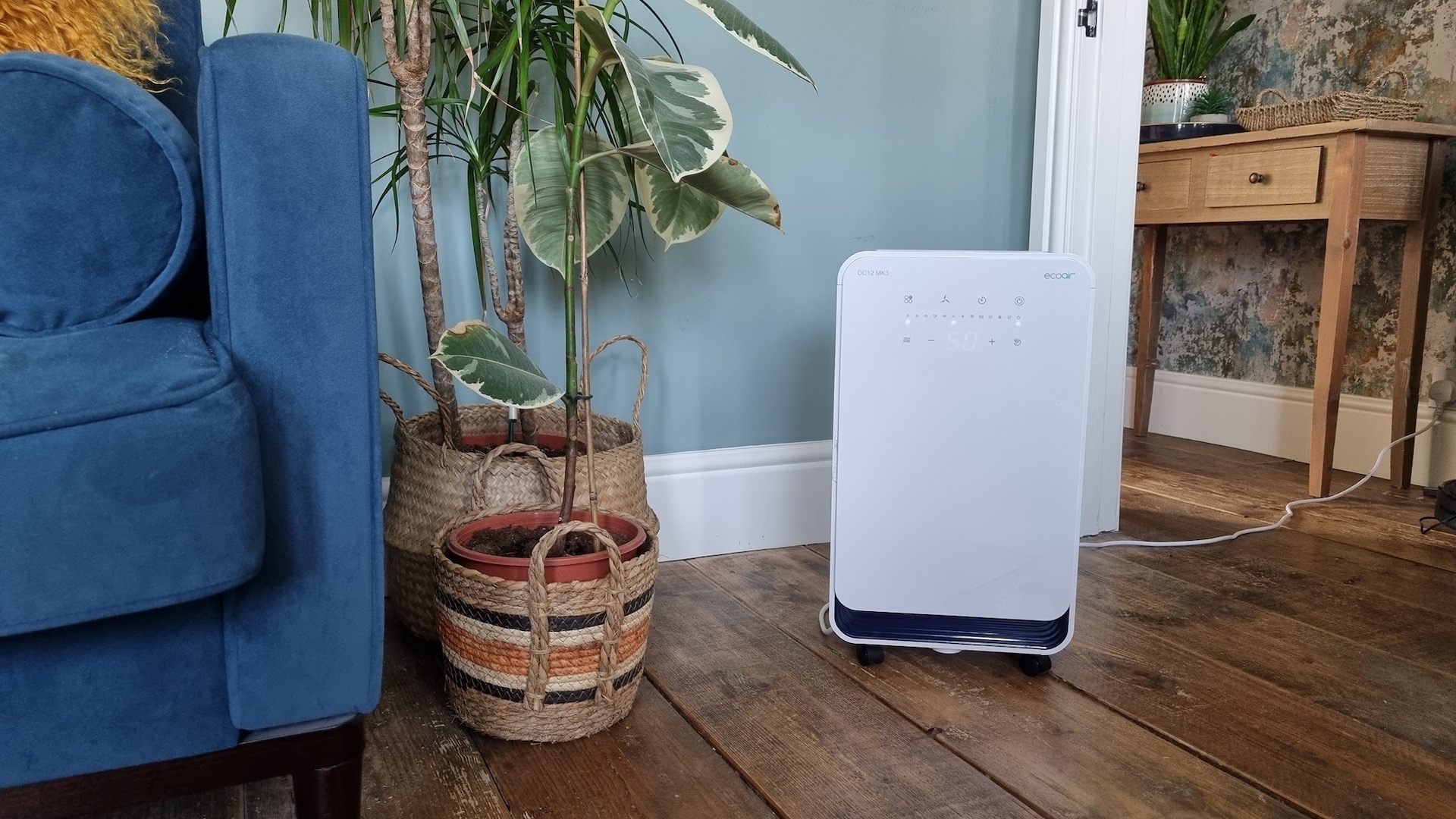
Power consumption
The EcoAir DC12 has a power consumption level of 210W. This compares to 151W for the best-in-class MeacoDry Arete with an equivalent 12ltr extraction rate and 155W for the Meaco ABC 12ltr model I tested. That means it costs more to run. But how much more?
To establish their running costs, take the wattage of the appliance and divide it by 1000 to get its kWh usage. Then take what you pay for energy per pence/kWh, and use the following calculation: kWh rate x electricity cost per kWh x number of hours the appliance is running.
For our calculations, we'll use the Government's January 2024 energy price cap of 29p per kWh. But you can look at your own bills to see what you're paying per kWh.
With this in mind, the maximum you'd pay to run each of the three dehumidifiers I tested would be:
- EcoAir DC12 Mk3: 0.210kWh x £0.29 x 6hrs = £0.37
- Meaco ABC 12ltr: 0.151 x £0.29 x 6hrs = £0.26
- DeLonghi Tasciugo AriaDry Multi 16L: 0.290 x £0.29 x 6hrs = £0.50
On that basis, the EcoAir is a middling performer when it comes to energy use in this category.
Who is the EcoAir DC12 MK3 right for?
A dehumidifier with a 12ltr-extraction rate is typically best for a one or two-bedroom apartment or house with high humidity, or a three-bedroom home with medium (50-60%) humidity. The size of this model, however, makes it especially suited to smaller homes.
The fact that it's fitted with castors makes it easier to roll from room to room on a hard floor – another reason why it's great for a flat or bungalow. I felt is was tricky to lift, so if you have stairs, I'd advise keeping it in one place – either a landing or hallway is best as the dehumidifier will still capture moisture effectively as the air circulates through your home.
EcoAir advises that wherever you choose to site your DC12, the room should be at least 4 sq m.
The model is designed to work within ambient temperatures of 15°C to 35°C, which is typical for a compressor model. However, this might catch you out on a very cold or hot day. If you have cold, often unoccupied rooms, a desiccant dehumidifier will suit you better.
Because it runs so quietly, this dehumidifier is a perfect option for a bedroom with condensation and mould issues. It's good at drying laundry, too, though I'd say the Meaco ABC that I tested alongside the EcoAir slightly edged it in this regard.
I did find it extremely effective – at times it brought humidity down to a lowly 40%. Given that some skin conditions require that you don't dry the air out too much, you should be careful to set this machine to a slightly higher humidity of 50% to avoid any irritation.
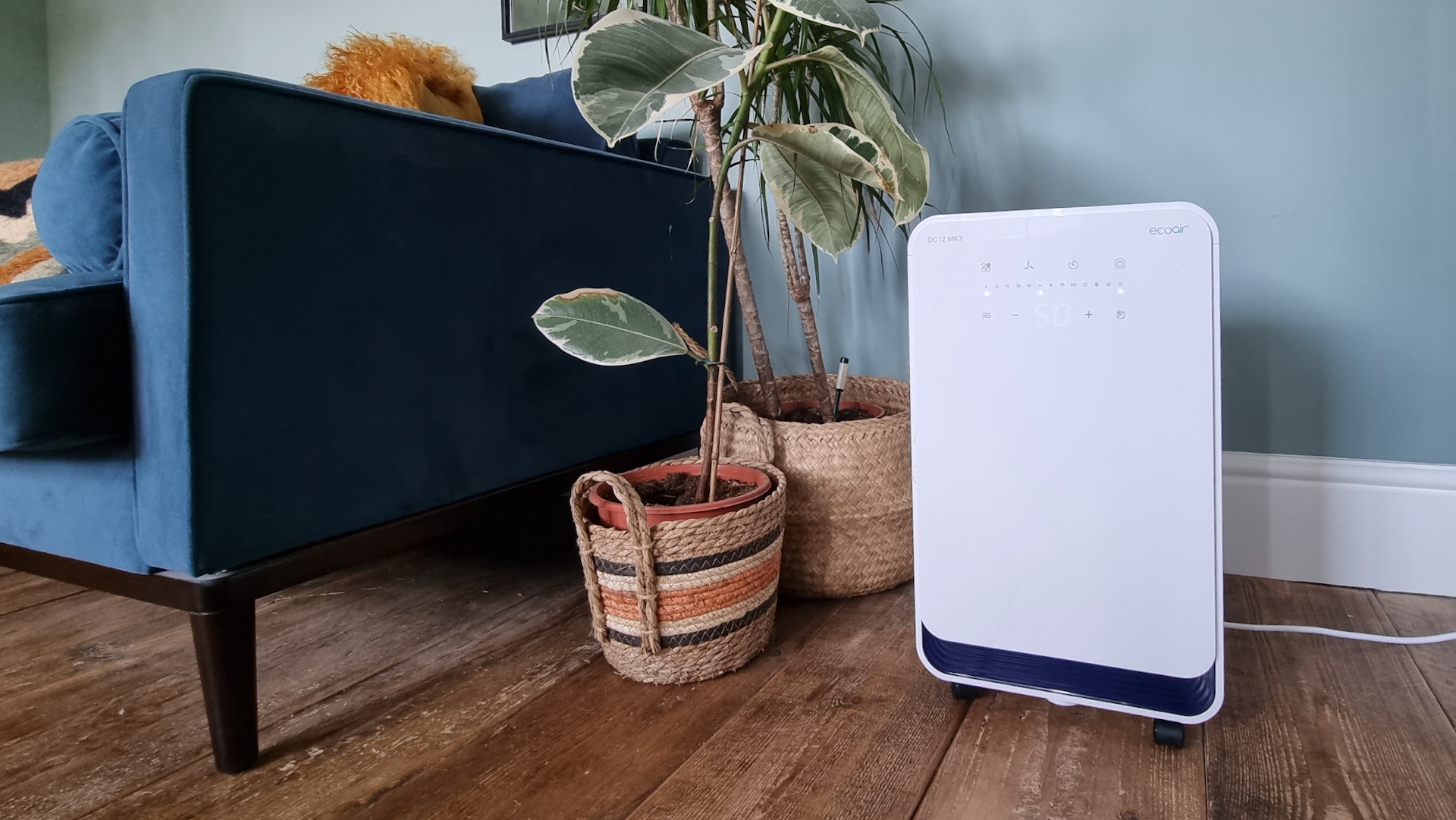
Should you buy the EcoAir DC12 MK3?
I'd never advise buying an appliance for the sake of it. So before you invest, check out what I wish I'd known before I bought a dehumidifier and judge if you really need one. If you think it's a good idea, and you are looking for an affordable compressor dehumidifier that's quiet and won't take up too much space, I highly recommend the EcoAir DC12 Mk3. I've seen it on sale for under £130, which makes it even more of a no-brainer buy.
The first big plus of the EcoAir is its size and looks. It's small for a compressor model, and that show-stopping touchscreen is a joy to use. I was happy to have it on display and it drew lots of interest from visitors. Yet despite its size it performed as well as compressors with the same daily extraction rate – and in the case of the Delonghi, larger extraction rates.
It really cuts into laundry times, and will do a fine job of keeping mould at bay, provided you don't put it in too large a space. If you are really pinching the pennies, however, be mindful that there are cheaper dehumidifiers out there when it comes to running costs (including two by Meaco). This one isn't the cheapest, but it's also a long way off being the most expensive in terms of energy use.
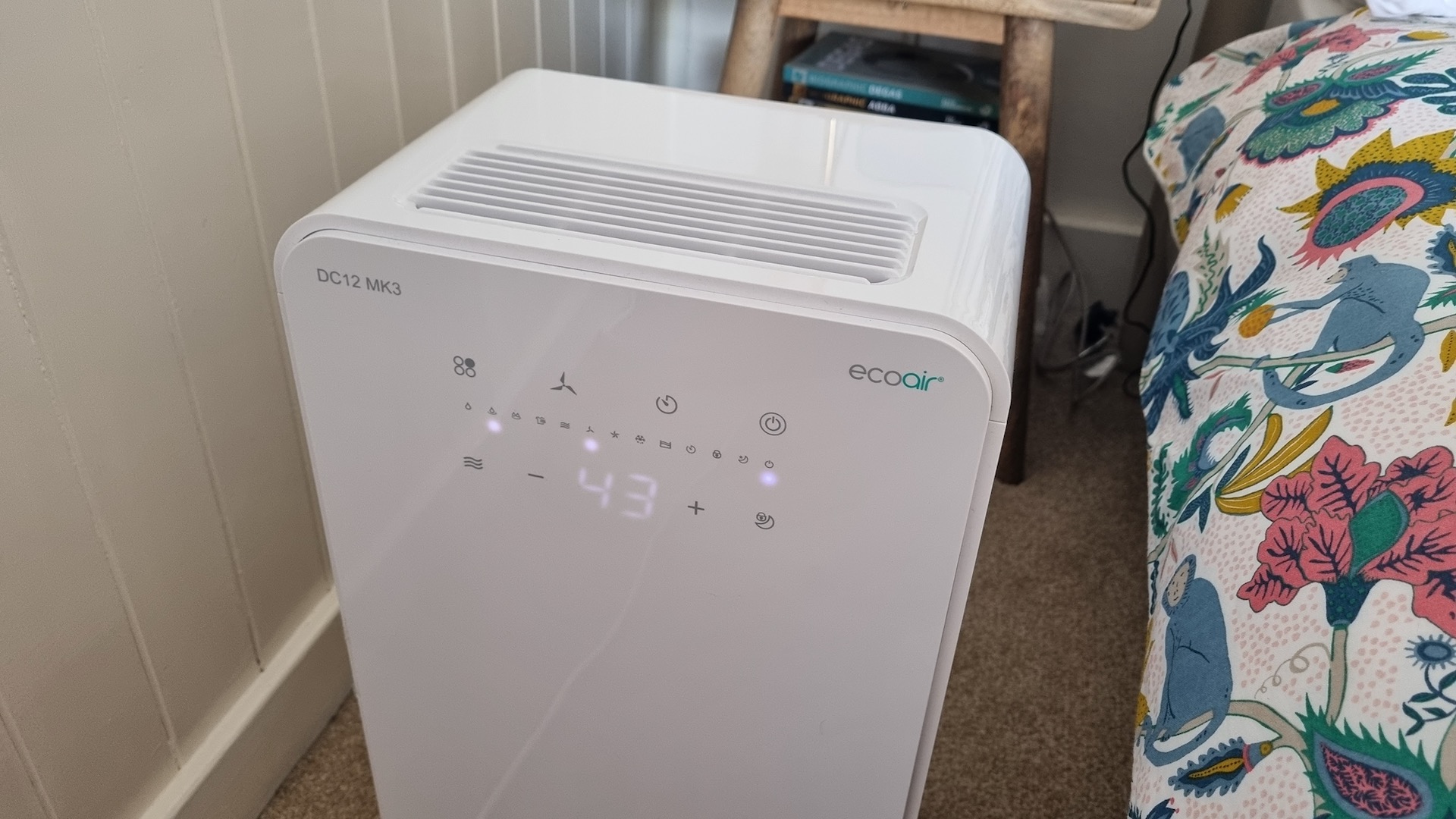
The DC12 is perfect for apartments due to its size but worked just fine in my three-bed semi. I think its sweet spot would probably be a two-bed house or flat, but I'm living with it happily and wouldn't feel the need to upgrade. It comes on castors, which makes it easy to wheel around on a hard floor.
Many larger, more expensive models don't come with castors, so this is a nice touch. However, if you want to cart this dehumidifier up and down stairs, it is relatively heavy, and its handle, at the back of the appliance, isn't easy or comfortable to grip. This could definitely be improved, design-wise.
Sure, it doesn't have bells and whistles like app controls or built-in HEPA air purifying. But it's definitely not an entry-level model, thanks to its stunning control panel, sleep model, laundry mode, child lock and castors.
And finally, let me reiterate how darn quiet it is in night mode. At times, I felt the need to jump out of bed to check that it was still running... but it was, so please don't do the same!




!["[T]he First and Fifth Amendments Require ICE to Provide Information About the Whereabouts of a Detained Person"](https://images.inkl.com/s3/publisher/cover/212/reason-cover.png?w=600)


